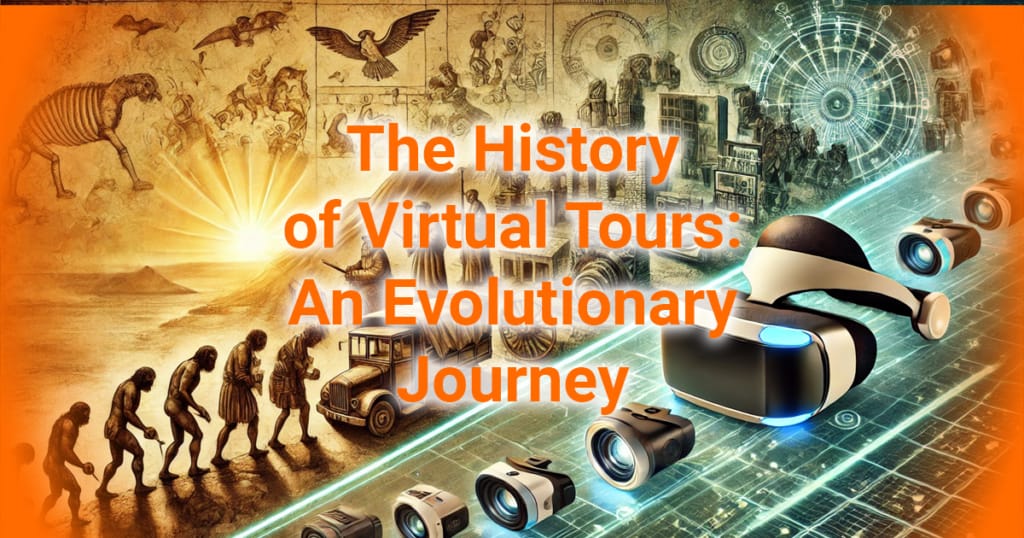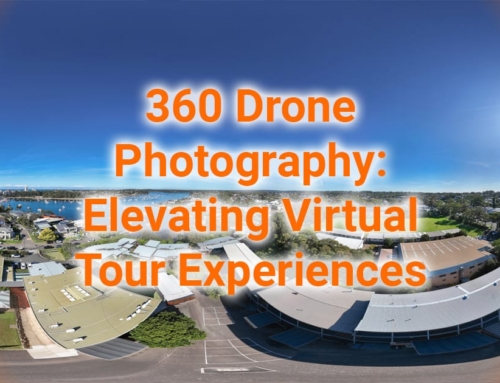The History of Virtual Tours: An Evolutionary Journey

Introduction
Imagine wandering through the grand halls of a centuries-old castle, strolling through the vibrant streets of a distant city, or marvelling at the intricate brushstrokes of a masterpiece—all without leaving the comfort of your home. This is the transformative power of virtual tours. In our increasingly digital world, virtual tours have revolutionised how we experience and interact with spaces, breaking down geographical barriers and bringing the world to our fingertips.
Virtual tours have evolved extraordinarily from their modest beginnings rooted in panoramic art to today’s sophisticated, interactive 360-degree experiences. They’ve moved from static images to dynamic, immersive journeys that engage multiple senses. This progression reflects technological advancements and a fundamental shift in consuming information and seeking experiences.
Businesses, educators, and adventurers alike have embraced virtual tours for their ability to inform, captivate, and inspire. They’ve become invaluable tools for showcasing properties, enhancing tourism, and providing educational experiences. As we delve into the history of virtual tours, we’ll explore the key innovations that have propelled their development, the milestones that have marked significant leaps forward, and the exciting possibilities that the future holds.
Join us on this evolutionary journey as we uncover how virtual tours have transformed from simple panoramic views into the immersive digital explorations we know today.
The Early Beginnings of Virtual Tours
The Dawn of Digital Exploration
The roots of virtual tours stretch back to the early 19th century when the world was hungry for new ways to experience distant places. Panoramic paintings emerged as a popular medium, captivating audiences with their sweeping depictions of landscapes, cityscapes, and historical events. These massive artworks were often displayed in specially designed rotundas, allowing viewers to stand in the centre and be enveloped by the scene—a precursor to the immersive experiences of today’s virtual tours.
In 1843, Austrian inventor Joseph Puchberger patented the first hand-cranked panoramic camera. This device enabled photographers to capture expansive vistas on a single piece of film by physically rotating the camera during exposure. It was a groundbreaking development that laid the foundation for panoramic photography. Puchberger’s camera allowed for a wider field of view than traditional cameras, offering a more comprehensive representation of scenes and landscapes.
In the mid-19th century, photographers experimented with daguerreotypes and calotype processes to create panoramic images. These early endeavours required meticulous attention to detail and significant technical skill, as multiple photographs had to be carefully aligned and merged. This process was both time-consuming and prone to errors. Despite these challenges, the resulting images gave viewers unprecedented visual access to places they might never visit, fuelling a growing appetite for virtual exploration.
Pioneering Technologies
As the 20th century approached, technological innovations continued to shape the evolution of panoramic imagery. In the 1960s, cinematographer Morton Heilig introduced the Sensorama, a revolutionary machine designed to stimulate multiple senses simultaneously. The Sensorama combined stereoscopic 3D visuals with sound, vibrations, and even scents to create an immersive experience. Users could, for example, feel the rumble of a motorcycle engine and smell the aromas of a city street as they “rode” through a virtual environment.
While the Sensorama wasn’t a virtual tour by today’s standards, it represented a significant leap toward immersive technology. Heilig’s work laid the groundwork for future virtual reality (VR) developments. It highlighted the potential for technology to transport users to different places and times. His vision of multisensory engagement remains a cornerstone of virtual tour experiences, underscoring the importance of creating real and engaging environments.
The Rise of 360-Degree Photography
Innovations in Imaging
The 1980s marked a pivotal era for the evolution of virtual tours. Advances in computer technology and imaging paved the way for new possibilities. Photographers and technologists began exploring digital means to create and display panoramic images. The development of Apple’s QuickTime VR in the 1990s allowed users to interact with panoramic pictures on personal computers for the first time, enabling a rudimentary form of virtual exploration.
In 1994, the term “virtual tour” was officially coined during a project for Britain’s Dudley Castle. The project involved a computer-based tour that reconstructed the castle as it appeared in 1550. Users can navigate the 3D environment and explore the historic site from their screens. This milestone bridged the gap between static panoramic images and interactive experiences, marking a significant moment in the history of virtual tours.
Development of IPIX Technology
The late 1990s saw the advent of IPIX technology, which played a crucial role in advancing 360-degree photography. IPIX enabled the creation and viewing of full 360-degree panoramic images, allowing users to look in any direction within a scene. This technology was a game-changer for businesses, particularly in the real estate and tourism industries, as it provided a more immersive way to showcase properties and destinations online.
By enabling users to virtually “stand” within a space and look around freely, IPIX set new standards for virtual tour quality. It also spurred increased interest in virtual tours as practical marketing tools, highlighting the potential for online experiences to influence real-world decisions.
Integration of Web-Based Virtual Tours
Launch of Google Maps and Google Earth
In 2005, Google Maps and Google Earth were launched, revolutionising digital navigation and exploration. While not virtual tours per se, these platforms allowed users to traverse the globe virtually, exploring cities, landscapes, and landmarks from a birds-eye view or street level. The introduction of Google Street View provided panoramic views along streets worldwide, significantly enhancing the public’s familiarity with virtual navigation.
These tools contributed to developing virtual tours by increasing public interest in digital exploration and setting user expectations for interactive, high-quality imagery. They demonstrated the feasibility and appeal of integrating maps with panoramic images, paving the way for more sophisticated virtual tour experiences.
Emergence of Web-Based Virtual Tours
With the increasing availability of high-speed internet, the late 2000s saw a surge in web-based virtual tours. Businesses across various industries began incorporating virtual tours into their websites to enhance customer engagement. Utilising 360-degree panoramic photography, these tours allowed potential customers to explore hotels, museums, universities, and more from anywhere in the world.
Advancements in software made it easier to stitch panoramic images together seamlessly, improving virtual tours’ overall quality and realism. This period also saw the introduction of interactive elements, such as clickable hotspots and informational pop-ups, which enriched the user experience and provided additional context.
Accessibility and Mainstream Adoption
Introduction of Affordable 360-Degree Cameras
The arrival of consumer-grade 360-degree cameras around 2010 marked a significant turning point in the accessibility of virtual tour creation. Devices like the Ricoh Theta and the Samsung Gear 360 made it possible for amateurs to capture panoramic images and videos without requiring specialised equipment or extensive technical knowledge.
While these early consumer models couldn’t match the professional quality offered by services like 360 Photography, they played a vital role in popularising 360-degree content. Social media platforms began supporting 360-degree photos and videos, encouraging users to share immersive content and increasing public interest in virtual tours.
Emergence of Mobile VR Platforms
The emergence of mobile VR platforms in 2014, such as Google Cardboard and Samsung Gear VR, further propelled the mainstream adoption of virtual tours. These affordable solutions transformed smartphones into virtual reality devices, making immersive experiences accessible to a broader audience. Users could now engage with virtual tours more interactively and engagingly, deepening their connection with the content.
This accessibility encouraged more businesses to invest in high-quality virtual tours to meet growing consumer expectations. Professional services began incorporating VR compatibility into their offerings, ensuring that virtual tours could be experienced seamlessly across various devices.
Establishing a New Standard in Virtual Tours
In 2017, Dimitri Cassimatis founded Simply 360, whose background in marketing and IT positioned the company at the forefront of virtual tour innovation. Recognising the growing demand for immersive experiences, Dimitri aimed to provide businesses with professional 360-degree Virtual Tours that captivated audiences and drove sales and marketing goals. By integrating marketing strategies with cutting-edge technology, Simply 360 set out to create virtual tours with a clear focus on enhancing business growth and customer engagement.
Below is an example of Simply 360 literally flipping the script on virtual tours Down Under style!
Double-click on the Down Under virtual tour to make it go fullscreen, or click here
Impact of the Pandemic on Virtual Tours
Surge in Virtual Tours Due to Global Events
The COVID-19 pandemic in 2020 had an unprecedented impact on virtually every industry worldwide. With lockdowns and social distancing measures in place, businesses and institutions faced the challenge of connecting with their audiences remotely. Virtual tours emerged as an essential solution, allowing organisations to maintain engagement and continue offering experiences despite physical limitations.
Museums, galleries, educational institutions, and event venues turned to virtual tours to provide access to their spaces. This surge in demand accelerated innovation in virtual tour technology, leading to higher-quality content and more interactive features. Businesses that previously relied on in-person interactions began to recognise the value of virtual tours as a long-term asset, not just a temporary fix.
Advancements Spurred by Necessity
The pandemic highlighted the importance of digital readiness and adaptability. Companies like Simply 360 stepped up to meet this need by offering advanced virtual tour services that provided immersive and interactive experiences. During this period, the industry’s increased reliance on virtual tours pushed it forward, leading to innovations in areas like 360 Virtual Tours and 360 Video, which have continued to benefit businesses even as restrictions have eased.
The Present State of Virtual Tours
High-Resolution and Interactivity
Today, virtual tours have evolved into sophisticated, high-resolution experiences that offer unparalleled levels of interactivity. Cutting-edge services like 360 Virtual Tours provide fully immersive, customer-branded tours that captivate audiences. These tours often include interactive elements such as informational hotspots, embedded multimedia, and navigation menus that allow users to explore spaces intuitively.
Advancements in drone technology have also expanded the possibilities of virtual tours. 360 Aerial Drone Photography offers unique aerial perspectives, capturing stunning panoramic views from above. This technology is particularly impactful for showcasing large properties, campuses, or scenic locations, providing viewers with a comprehensive understanding of the space.
Services Elevating Virtual Tours
Professional virtual tour providers play a crucial role in elevating the quality and effectiveness of virtual tours. By utilising advanced equipment and software, they ensure that images are crisp, transitions are smooth, and the overall experience is engaging. Moreover, services often include Marketing Consultancy to help businesses integrate virtual tours into their broader marketing strategies, maximising their impact.
Expertise in 360 Video and traditional DSLR photography further enhances the content’s versatility. By combining different mediums, businesses can create rich multimedia experiences that cater to diverse audience preferences.
The Future of Virtual Tours
Emerging Technologies
Several emerging technologies are set to shape the future of virtual tours. Artificial Intelligence (AI) promises to personalise virtual tour experiences by adapting content based on user behaviour and preferences. AI could enable virtual assistants within tours, providing real-time information and answering user queries, further enhancing engagement.
Augmented Reality (AR) is another exciting frontier. By overlaying digital information onto the physical world, AR has the potential to blend virtual tours with real-world exploration. Users could, for example, point their device at a building and access an immersive virtual tour of its interior, seamlessly integrating physical and digital experiences. We are partnering with Pink Caviar Events to bring their AR vision to life.
Expanding Horizons
The applications of virtual tours are expanding beyond traditional sectors. Virtual tours offer students immersive learning experiences in education, from exploring historical sites to examining the inner workings of complex machinery. Virtual tours can familiarise patients with healthcare medical facilities, reducing anxiety and improving patient satisfaction.
The future of virtual tours also includes increased accessibility and inclusivity. Technological advancements are making it easier for individuals with disabilities to engage with virtual content. Features like audio descriptions, closed captions, and adaptable interfaces ensure that a wider audience can enjoy virtual tours.
As businesses continue to recognise the value of virtual tours, the demand for high-quality, professional services is likely to grow. Innovations will focus on enhancing realism, interactivity, and user engagement, solidifying virtual tours as an essential tool in the digital landscape.
Conclusion
From the panoramic paintings of the 19th century to the immersive digital experiences of today, the history of virtual tours is a testament to human ingenuity and our desire to explore beyond physical limitations. The evolution of virtual tours reflects a continuous pursuit of innovation driven by technological advancements and changing consumer expectations.
Today, virtual tours are more than a novelty—they’re a powerful medium for storytelling, marketing, and education. They offer businesses a unique opportunity to engage audiences, showcase offerings, and stand out in a crowded digital marketplace. By embracing modern virtual tour solutions, companies can connect with customers meaningfully, building trust and fostering lasting relationships.
Ready to elevate your business with a high-end custom-branded virtual tour? Contact us at 9674 9090 or email us to get started.
How do you see virtual tours shaping the future of your industry? What aspects of virtual tour technology excite you the most? Are you ready to take your audience on an immersive journey? We’d love to hear your thoughts! Check out the comments section below and join the discussion.








The breakdown of how virtual tours have evolved over time is really insightful. It’s interesting to see how this technology has become such a powerful tool for businesses and government organisations. The shift towards more immersive experiences is definitely changing the way people engage with spaces.
Glad you found it insightful! Virtual tours have come a long way, and it’s exciting to see how businesses and organisations are using them to enhance engagement and accessibility. The way this technology continues to evolve will be interesting to watch.
Virtual tours have revolutionised the way businesses and organisations present their spaces. The ability to provide an immersive experience remotely is a game-changer, especially for industries that rely on customer engagement. Do you think advancements in AI will make virtual tours even more interactive in the future?
That’s a great question, Jarrett! AI is already starting to play a role in enhancing virtual tours by personalising experiences and making them more interactive. As technology progresses, we’ll likely see even more dynamic features that adapt in real-time to user preferences.
The history of virtual tours is really fascinating. It’s impressive how they’ve evolved from simple 360-degree images to fully interactive experiences. This kind of innovation has completely changed how businesses and organisations showcase their spaces.
Absolutely! The evolution of virtual tours has made them an essential tool for businesses looking to create engaging and accessible experiences. As technology continues to improve, we’re seeing even more possibilities for interactive and immersive virtual environments.
It’s amazing to see how virtual tours have evolved from basic static images to fully immersive experiences. They’re becoming an essential tool for businesses looking to improve engagement and accessibility. The potential for future advancements in this space is really exciting!
Definitely! Virtual tours have come a long way, and with ongoing advancements in technology, they’ll continue to offer even more interactive and engaging experiences. It’s exciting to see how different industries are leveraging them to connect with their audiences.
t’s incredible to see how virtual tours have transformed over time. What started as simple imagery has evolved into fully interactive experiences that businesses and organisations can use to engage with their audience in new ways. The impact on accessibility and customer engagement is undeniable.
Absolutely! The ability to offer an interactive and immersive experience has changed the way businesses connect with their audience. As technology continues to improve, virtual tours will only become more dynamic and valuable across different industries.
The way virtual tours have developed over time is truly impressive. They’ve gone from simple static images to fully interactive experiences that allow users to explore spaces remotely. Do you think businesses that don’t adopt this technology will struggle to keep up?
That’s a great point! Virtual tours have become a key tool for engagement, and businesses that don’t embrace them may find themselves at a disadvantage, especially in industries where showcasing a space is crucial. As customer expectations shift, having an interactive digital presence is becoming more important than ever.
Virtual tours have changed the way businesses and organisations showcase their spaces. It’s amazing how they can create an immersive experience without the need for in-person visits. Do you think this technology will eventually replace traditional site visits entirely?
That’s an interesting thought! While virtual tours offer incredible convenience and accessibility, there will likely always be situations where an in-person visit is necessary. However, they are definitely becoming a preferred first step for many industries, saving time and resources while still providing a detailed look at a space.
The history of virtual tours is fascinating! It’s impressive how they’ve evolved from simple panoramic images to fully interactive experiences. With the rise of AI and automation, do you think virtual tours will become even more personalised in the future?
Absolutely! AI is already being used to enhance virtual tours by tailoring experiences based on user preferences and behaviour. As technology advances, we’ll likely see even more dynamic and interactive tours that adapt in real time to provide a more personalised experience.
It’s interesting to see how virtual tours have evolved into such an essential tool for businesses and government organisations. The ability to provide immersive experiences remotely has changed the way people interact with spaces. Do you think advancements like AI and VR will push virtual tours even further in the next few years?
That’s definitely where things seem to be heading! AI is already improving virtual tours by making them more interactive and personalised, and VR is opening up new possibilities for fully immersive experiences. As these technologies develop, virtual tours will likely become even more engaging and useful across different industries.
It’s incredible how virtual tours have shifted from simple images to fully interactive experiences. With so many industries adopting them, do you think they’ll eventually become a standard expectation rather than a unique feature?
That’s a great question, Elijah! We’re already seeing virtual tours becoming a key part of customer engagement strategies, especially in sectors like education, government, and hospitality. As technology improves, I think they’ll move from being a ‘nice-to-have’ to an essential tool for businesses wanting to stay competitive.
The evolution of virtual tours really highlights how technology has changed the way businesses and organisations connect with their audiences. From early innovations to today’s interactive experiences, it’s clear that virtual tours are here to stay.
It’s impressive to see how virtual tours have developed into such a valuable tool for businesses and organisations. The ability to create immersive experiences for customers and stakeholders is a game-changer. Great insights in this article!
The way virtual tours have evolved over the years is truly remarkable. It’s interesting to see how businesses and government organisations are using them to create more engaging and accessible experiences. A really insightful article!
There’s something truly engaging about being able to explore a space virtually before visiting in person. Virtual tours provide an incredible way to experience locations remotely, offering accessibility and convenience that can enhance decision-making for businesses and organisations alike. Really enjoyed this read!
The transformation of virtual tours over the years is truly impressive. It’s interesting to see how businesses and government agencies are leveraging them to connect with their audiences in new ways. Great insights in this article!
It’s fascinating to see how virtual tours have evolved into such a valuable tool for businesses and government organisations. The insights in this article really highlight their impact on customer engagement and accessibility. Great read!
It’s incredible to see how virtual tours have evolved over time. They’ve become such a powerful tool for businesses and government organisations looking to improve engagement and accessibility. This article provided great insights—thanks for sharing!
The evolution of virtual tours is truly impressive! It’s great to see how businesses and government organisations are using them to engage with their audiences in new and innovative ways. A really insightful read!
The history of virtual tours is really interesting! It’s amazing to see how far they’ve come and how they’re now being used to enhance customer engagement and accessibility. A great read—thanks for sharing!
It’s fascinating to see how virtual tours have evolved into such a valuable tool for businesses and government organisations. The insights in this article really highlight their impact on customer engagement and accessibility. Great read!
Virtual tours have come a long way! It’s incredible to see how technology has shaped them into such a useful tool for businesses and organisations. This article provided great insights—thanks for sharing!
The evolution of virtual tours is truly impressive! It’s great to see how businesses and organisations are using them today to engage with their audience. A really insightful read!
I really enjoyed this deep dive into the history of virtual tours. It’s amazing to see how they’ve evolved into such a powerful tool for marketing and engagement. Thanks for the insights!
It’s fascinating to see how virtual tours have changed over time. The improvements in technology have really made them a valuable tool for businesses looking to enhance customer engagement. Great insights!
I never realised how much virtual tours have evolved over the years! This was a great read, especially in understanding how they can be applied in different industries today.
Virtual tours have come such a long way! It’s incredible to see how they started and how businesses now use them for marketing and customer engagement. Thanks for the great insights!
The history of virtual tours is really interesting! It’s amazing to see how they have gone from basic images to fully immersive experiences. This article helped me understand how businesses can use them effectively.
It’s fascinating to see how virtual tours have evolved over time. The technological advancements and their impact on customer engagement are impressive. This article provided great insights into how businesses can leverage these changes!
The way virtual tours have progressed from basic images to fully interactive experiences is incredible. It’s interesting to see how different industries have embraced this technology to improve accessibility and engagement.
It’s amazing to see how virtual tours have evolved over the years. What started as simple panoramic images has now become a highly interactive tool for businesses and organisations. It makes me wonder—what’s the next big innovation in this space?
That’s a great question, Ana! With advancements in AI, AR, and VR, virtual tours are becoming even more immersive. We’re already seeing features like guided narration, real-time interactions, and custom branding, and there’s still so much potential for growth.